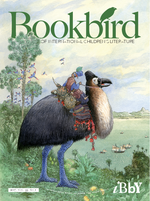Bookbird 1 / 2017
Bookbird or Bookworm – or both? If the bird represents the visual – both because of its striking appearance and because of its keen eyes, surveying the land – the worm digests the letters, the words, thinking and imagining. In this issue we sometimes take the bird’s eye view, sometimes dig into the words with worm-like appetite. Picturebooks are the main focus in Penni Cotton’s article on a travelling exhibition of “Lampedusa’s Silent Books” that has been used to engage school children in the small French town of Montolieu in various ways.
Picturebooks are also featured in two of the full-length articles in this issue. Christèle Maizonniaux discusses the challenges and possibilities, linguistic as well as cultural, involved in using franco- phone picturebooks with Australian university students who are studying French at tertiary level. Then we have Jessica Whitelaw who discusses what she calls “disquieting picturebooks”: books that address sensitive issues, or are aesthetically complex, or are politically radical. There is a great deal more of visual content in this issue, ranging from Francois Place’s beautiful cover image to the many picture postcards from all over the world, including a “Letter” article by Anzhela Lebedeva on a Russian “Postcard competi tion.” However, far from being a “silent journal,” Bookbird is also a Bookworm. Thus, there are several texts that focus on writing and words, rather than illustrations. Beatriz Alcubierre Moya and Rodrigo Bazán Bonfil write about José Vasconcelos’ classic Mexican children’s books, while Junko Sakoi and Yoo Kyung Sung bring up a much neglected subject with their article on the stories and situation of the indigenous Ainu people (on the island of Hokkaido in Japan). Finally, in a lead to the next themed issue of Bookbird (“child authors,” forthcoming, Spring 2017), Jenni Woodroffe writes about “Children Creating Their Own Books.” Picturebooks may be wordless, but they are never world-less. Children’s books are worlds to enter and explore. And children can enter these worlds through words or images, or make them up themselves.


